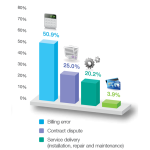How much does your business spend on mobility services each month? For most businesses, it’s a significant percentage of the overall telecom budget and too often they are overpaying!
Overspending on mobility is two-sided. The problem begins with the telecom service providers; their billing systems are not to date, and create billing anomalies that are at the expense of their customers. On the flip side, many businesses underestimate the amount these billing errors add up to. Therefore, they have not taken the time to put a system in place to identify them, or set aside the time.
Quite often businesses perform a simple review to make sure that mobility expenses are about the same as the previous month’s, and then the bills are paid. If you are not requesting for credits each month, you are not effectively catching errors.
When reviewing a mobility bill, it should be treated like a puzzle or a riddle. There are always errors and opportunities for savings; you just have to solve the puzzle.
I recently had the opportunity to review a customer’s mobility bills for the first time. We’ve worked with this client on other aspects of their telecom needs for years, but they’ve always been confident with managing their mobility billing internally:
- “We only have 40 devices.”
- “We have a great contract with great plans.”
- “We have pooling, so we’re fine.”
- “It only takes me a few minutes each month to review the bill because it’s so straightforward.”
Our customer is an insurance provider with 30 employees and 40 smartphones and tablets. They are very similar to a lot of small/medium Canadian businesses: they don’t have the need (or the budget) for a full-time onsite telecom employee. While it was commonplace years ago for organizations to have a dedicated telecom resource, IT departments have evolved and are operating on a lean budget, forcing IT to take on the responsibilities of telecommunications.
This particular customer understands that telecom requires a unique skillset that most IT staff don’t have, so they outsource any telecom requirements that are outside of their team’s experience. Outsourcing results in cost-savings at a couple of levels: for this customer, the cost to outsource is less than a part-time employee, and outsourcing to experts ensures that the job is done correctly and efficiently. Time is not wasted learning on the job, and employees can focus on their core responsibilities.
That said, they’ve managed their mobility contract and monthly invoices internally for years, because they were confident with the contract they negotiated with their carrier and were confident that the billing was correct.
After reviewing their bill for the first time, I compiled a list of recommendations that will save them 30% every single month. What could you do with 30% of your monthly bill going back into your budget?
In the next installment of this blog series, we’ll look at how I was able to save this customer so much, so quickly.
Jennifer Caley,
TEM & WTEM Expert, Service Desk Manager of Nielsen IT Consulting Inc.
Would you like to be surprised by the savings opportunities that are hidden in your mobility bills? Call Jennifer today at 519-963-3035 or email jcaley@nielsenitconsulting.com for a no-risk audit. Remember, the errors and savings opportunities are always there – let Jennifer solve the puzzle and put money back into your budget.
Mobility Cost-Saving Case Study
Over this blog series, Nielsen IT’s mobility service expert Jennifer Caley will explore the importance of a monthly billing review, routinely scheduled contract renegotiation, and tips for regularly renewing your hardware fleet with current technology at minimal cost to the business.




